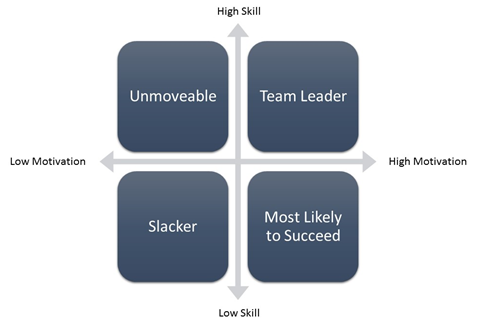In a previous Tip Sheet I’ve discussed how the motivation and skill of individual sellers have a direct impact on your company’s growth. And, that once you evaluate team members, you’ll know if sales training is needed and how to customize it.
Now it’s time for specifics. How can you determine, more precisely, where individual sellers fall on the motivation and skill spectrum? How can you leverage and nurture their abilities? And, how can you fully apply sales training and hold sellers responsible for their progress?
Let’s start by identifying the four styles of sellers:
- Unmovable
- Slacker
- Most Likely to Succeed
- Team Leader
Use the diagnostic tool below to divide your sales team into these different categories.
Notice that skill is on the vertical line with high skill at top and low skill at bottom. On the horizontal line is motivation, with low motivation at left and high motivation at right.
If we work through this chart, here’s what we’ll find for each type of seller:
Unmovable
These are individuals with low motivation and high skill. Therefore, training them with new ideas to make them change and achieve growth won’t work. They’re content with the strong skill set they have — hence, unmovable. They’re not willing to learn new methods to achieve better results. Often, Unmovables are veteran sellers who are happy with where they’re at: managing current accounts, not having to make new calls, and satisfied with their current salaries.
Instead of trying to make them grow your company or adopt new ideas, Unmovable sellers could do much better with maintaining your business and account management. Consider reallocating them to new roles that play into their talents, such as account managers, or providing training that leverages what they’re already great at and are motivated to do more of.
For example, a client in the manufacturing field needed to grow the business by 12 per cent. However, the seller that covered the health and beauty sector — and the company’s biggest client — flat out refused to participate and was visibly hostile during a training session. She was unmotivated to accept new ideas, yet was very skilled and successful at what she was doing.
Evaluating the situation, we determined her expertise was this major health and beauty customer. We changed her pay and made her sole objective to manage the one client. The result? She’s pulling in even higher numbers on the account and the company is happier.
Slacker
These are sellers with both low motivation and low skill. Slackers won’t grow your company. They also won’t expand current accounts because they lack skill and don’t want to learn. Essentially, there’s no use for Slackers on the sales team, so let them go.
Most Likely to Succeed
This covers team members with high motivation and low skill. They want to grow and try new things — but they lack the know-how.
These are individuals you need to train, coach and mentor because they’re your future superstars! Stay on top of them and make sure they’re applying new sales skills on a regular basis to grow your business. Recognize and celebrate their wins with them. Add bonuses to keep them motivated.
Team Leader
These sellers are the cream of the crop with both high motivation and high skill. They’re the top one or two individuals on your sales team. They’re always over target and they’re growing the business like crazy.
With Team Leaders, the key is leveraging them to encourage growth among your other sellers. For example, you can:
- Make them subject matter experts within the company
- Give them new projects
- Allow them to expand their territories or have better ones
- Join them out on sales calls to document how they’re achieving success
- Let them run monthly training sessions to give them a leadership role
A natural resources company I work with followed this last step with great results. A number of people on the sales team were struggling to hit their quotas, so the VP assigned a seller that was a Team Leader to run training segments of the weekly sales meetings. The struggling sellers saw this colleague sharing techniques that worked and it motivated everyone to quickly adopt them. Sales, in turn, were driven upward.
Apply and hold responsible
Once you’ve classified your sellers and the initial sales training is complete, it’s time for your company leaders to buckle down. That means using two powerful drivers of growth: application and responsibility.
To avoid sales training falling to the wayside, the leadership team must install the framework for application and responsibility before the first training session. This means:
- Plan to measure progress
- Set targets
- Tell sellers they’re responsible for what they learn
- Schedule coaching sessions
Then, after training, the leaders need to closely coach and monitor activity. Have sellers document the top three ideas they’re committed to applying. Compile a list and share with the sales team so everyone remembers what they thought was best practice. Use this list in your one-on-one coaching sessions.
“Hey Bill, you mentioned your top three priorities for this week. Were you able to take care of them? Is there anything from me that you need to help you succeed?”
Once those first three items are in effect, return to the list to determine the next set of priorities.
Create personal goals
It also works to establish growth targets for individuals rather than a broad one for everyone. A temporary staffing company client had a positive outcome with this. He tracked seller progress through activity-based key performance indicators (KPIs), which both provided an early warning if something needed correcting and gave ongoing feedback about which activities were best for achieving particular kinds of sales.
This client also held the sellers responsible through one-on-one coaching, regular sales meetings, and executive gatherings to go over KPIs and prospects. Within a year of sales coaching, the team achieved their growth targets each month and, for the past two years, has broken new sales records each successive quarter.
Every company can achieve this type of growth. The first step is to always understand where your team members fit within the skill and motivation matrix, followed by appropriate training. After that, all it takes is a deep focus on application and responsibility. With these drivers of growth, you’ll be surprised how quickly your sales take off!
Colleen Francis, Sales Expert, is Founder and President of Engage Selling Solutions (www.EngageSelling.com). Armed with skills developed from years of experience, Colleen helps clients realize immediate results, achieve lasting success and permanently raise their bottom line.






